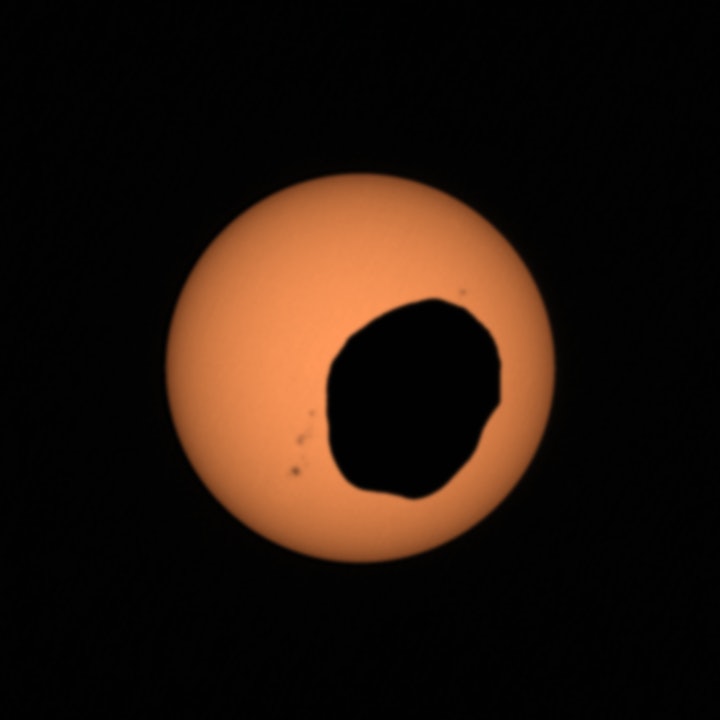
NASA’s Perseverance rover is looking for signs of ancient alien life on Mars — but that doesn’t stop it from staring up at the sky now and then. Now, NASA reveals on April 2 the rover stared at the Sun (clearly ignoring the advice of scientists and grade school teachers everywhere) and captured a kind of eclipse only possible on Mars.
On that day, Mars’ largest moon Phobos crossed between the rover and the Sun, eclipsing the star. The jaw-dropping footage shows the latest in the record of eclipses caught on camera by Mars rovers. But it’s not an eclipse like we think of on Earth.
Spectators of the 2017 total solar eclipse in North America and other latitudes saw the disc of the Moon completely cover the Sun, casting day into night for around two minutes and 40 seconds, if you were in the right spot. That’s not how it went down on Mars, however.
A Martian moon eclipse
Mars’ moon Phobos is small — just 14 miles in diameter — and much closer to Mars than our Moon is to Earth. Phobos hovers just 3,700 miles above Mars. That makes it close enough that it will eventually get ripped apart by Mars’ gravity, briefly becoming a ring in a few tens of million years before falling down to Mars
Thus, Phobos can never really blot out the Sun like the Moon can. Total eclipses on Earth have to do with the chance size and distance of the Moon being just enough, in the right circumstances, to completely block out the Sun. At best, Phobos can block out about 40 percent of the Sun. It is enough to cause a noticeable change, but not enough to put on the show we’re used to on Earth when everything aligns just right.
Also because of its fast orbit — seven hours and 49 minutes — Phobos eclipses often last for less than a minute. Compare that to the Moon, which can blot out the Sun completely for upwards of seven minutes if everything is just right.
In this case, NASA says the April Phobos eclipse lasted 40 seconds — a whole five seconds longer than one spotted by Curiosity in 2019. Phobos eclipses happen in cycles of about once per year, but sometimes two eclipses happen in a day due to its swift orbit.
“It feels like a birthday or holiday when they arrive,” Rachel Howson, a Malin Space Science Systems employee who works on the Mastcam-Z instrument, says in a JPL press release.
“You know what’s coming, but there is still an element of surprise when you get to see the final product.”
The video shows details of the lumpen moon, which is either a captured asteroid or a fragment of Mars shot into orbit by a large impact.
The unique capabilities of the Perseverance rover allowed NASA to not only image the event, but capture video of it. Mastcam-Z is one of the high-tech imagers on the rover, and it zoomed in on the Sun and witnessed all 40 seconds of the eclipse, relaying the video back to the rover’s team at NASA’s Jet Propulsion Laboratory. Thanks to a solar filter, the rover won’t go blind — unlike you if you stare at the Sun unprotected.







